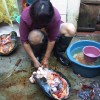Posts tagged barcoding

DNA sequencing helps discover cavemen’s tools and diet
Feb 17th
Posted by Oscar Pineda-Catalan in DNA Barcoding
In the 1970s a team of archaeologists led by Carl Gustafson unearthed the remains of a single, 3-ton, male mastodon (Mammut americanum, a close relative of mammoths and elephants), hunted and butchered by a group of men at the Manis site in the state of Washington, USA (Gustafson 1979). Among the mastodon remains they found a spear point that pierced a rib bone. Luckily for us the hunters did not recover the projectile weapon. We thus have evidence of the technology that cavemen in the Americas used to secure their food.
Originally Gustafson and his colleagues dated the mastodon hunting at More >
DNA in a cup of water
Jan 23rd
Posted by Melissa Lee in DNA Barcoding
In the movie, “Signs”, one of the characters, Bo, has an interesting habit of leaving half-full glasses of water lying around the house. To Bo, the water “tastes funny” after she drinks only a few sips of it. This odd habit becomes instrumental in the story’s ending. (I will not spoil it for those of you who have never watched this film!)
Incidentally, water can taste funny due to substances and/or forms of life found in it. Too bad Bo wasn’t a scientist. Perhaps she could have extracted DNA from each glass of water and found out the kinds of organisms More >

A virus in my meal?
Jan 19th
Posted by Oscar Pineda-Catalan in DNA Barcoding
Could the meat in your plate pose a health risk for you? If the animal where it came from was properly raised and handled, and the meat went through a sanitary inspection before reaching your plate, there is little chance it can cause you a health problem. But, what could happen if a sanitary authority has not inspected it?
Your meat indeed could be a high risk for your health. In some cases this can be a public concern, because meat can be a source of pathogens that could cause a disease outbreak. In fact, it has been documented that close interaction More >

Welcome to the DNA Barcoding Blog!
Sep 7th
Posted by Melissa Lee in DNA Barcoding
Welcome to our new DNA barcoding blog. It truly is an exciting time to be involved in this aspect of genomic science as DNA barcoding has been used to identify new species, help explain the biodiversity of our planet and even detect food fraud. Just as a universal product code (UPC) identifies an item for sale in a store, a DNA barcode uniquely identifies each species of living thing. The DNA barcoding technique includes extraction of DNA from an organism of interest, ampliflication of this DNA through PCR (Polymerase Chain Reaction), and sequencing of the DNA at specific locations in More >
